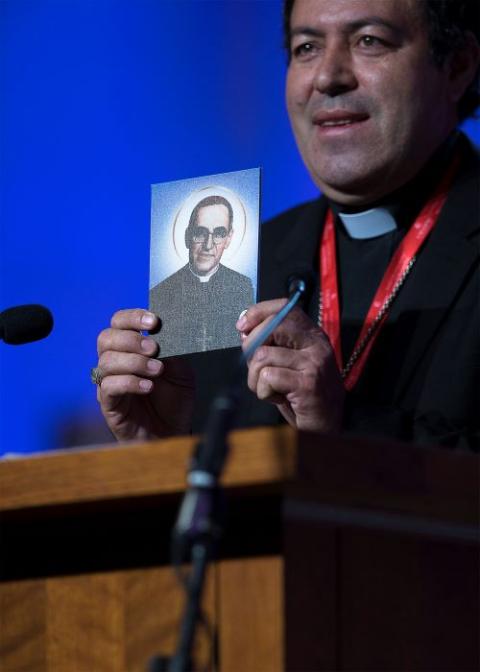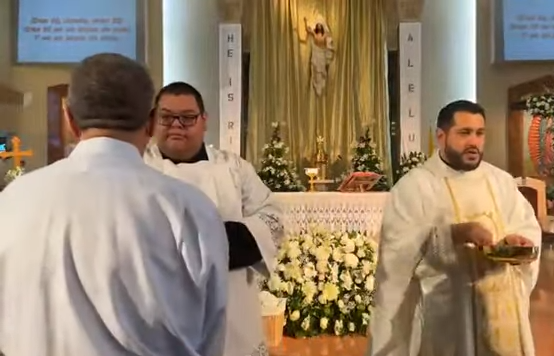
Communion is distributed during an Easter Mass April 9 at St. Emydius Church in Los Angeles County, California. The parish of 20,000 families offers 10 Sunday Masses, 9 of which are celebrated in Spanish. (NCR Photo/YouTube/St. Emydius Church)
If you sit in crawling traffic on an urban arterial, or speed down the smooth six lanes of a sprawling suburban boulevard, you'll see the architecture of America's new religious identities. A minaret points skyward next to the squat dome of a brand new mosque. Hindu temples, Sikh gurdwaras and Protestant megachurches sit in splendor in seas of black asphalt. Two holy words shared across all these faiths are "ample parking."
But that's not the whole story.
The country's inner-ring suburbs are now the home of Black Baptist congregations comfortably inhabiting synagogues, and Latino Catholics sit in pews built for first-generation suburbanites, in the Catholic churches built in Suffolk County, New York, just past the Chicago city line in Cook County, Illinois, and in the vast ocean of constantly changing cities in Los Angeles County, California.
St. Emydius Roman Catholic Church has a parking lot. Since I was arriving just before Mass, there was no way I was going to squeeze my rental into a stray space somewhere. Nope. I was going to circle a while, park several blocks away and quickly hoof it to be in place for the procession.
I walked past rows of small, neat, single-family homes, many built during the rapid growth of Los Angeles County during and after the Second World War. Towering palm trees stood guard at the curbsides, and inside the small fences stood carefully tended gardens stuffed with succulents, sitting adjacent to driveways stuffed with automobiles. When these houses were built, a car for each family was one of the whispered promises of the good life waiting in Los Angeles. Now every member of the family from teen-age on aspires to have a car, and it shows. Every inch of curb was also crammed with the cars of people who knew enough to arrive early, right up to the church's front door.
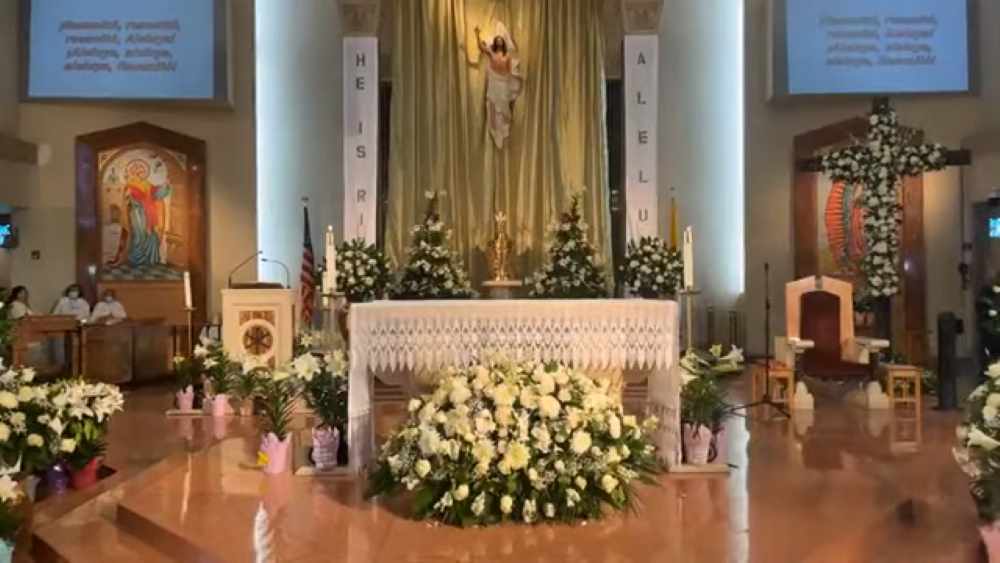
The altar at St. Emydius Roman Church in Los Angeles County, California, is dressed with flowers for Easter. At right, a flower-covered cross stands in front of an image of Our Lady of Guadalupe. (NCR Photo/YouTube)
More than 20 years ago I published a book about what happened to big American cities in the decades after the Second World War. During my research I traipsed through aged and sometimes rebuilding center city neighborhoods in Brooklyn, Chicago, Cleveland and Philadelphia. It didn't take an ethnographer, a genius or anything more than a competent reporter to notice throughlines in the Catholic churches built during the long Ellis Island era of American immigration.
Lovely old buildings where God was praised and petitioned in Polish, German, Croatian, Italian and Irish-accented English rose in the crowded neighborhoods around steel mills, breweries and car factories. These once-cherished, and now, left-behind buildings baptized, betrothed and buried a few generations of immigrant stock, and then were left behind as increasingly affluent families headed for greener pastures. When the archdiocese announces another parish closure it makes the local news, sends suburbanites on sentimental journeys back to the places where Mom and Dad were married, where a last goodbye was said for Nonna and Opa and Mam. By now it's an old American story, as old as the church in America, really, but constantly writing an update in real time.
Demographic realities
I'm currently writing the final chapters of a book on modern immigration to the United States in the decades after the Immigration and Nationality Act of 1965 threw open America's doors to new immigrants from the world outside Europe. One of the unintended consequences of that law, signed by President Lyndon Johnson at the base of the Statue of Liberty in New York harbor, was to transform America's religious landscape.
For a long time, it has been commonplace among people who study American religion to observe two big demographic "truths:"
- Roman Catholics are, by far, the largest religious group in America, and former Catholics are the second largest.
- Absent Latino Catholics, the church would never have, in effect, "broken even" in numbers over the last several decades, even as so many American denominations experienced demographic meltdown.
Not so fast, said Jesuit Fr. Allan Figueroa Deck, Distinguished Scholar of Theology and Latino Studies at Loyola Marymount University and professor of theological studies there.
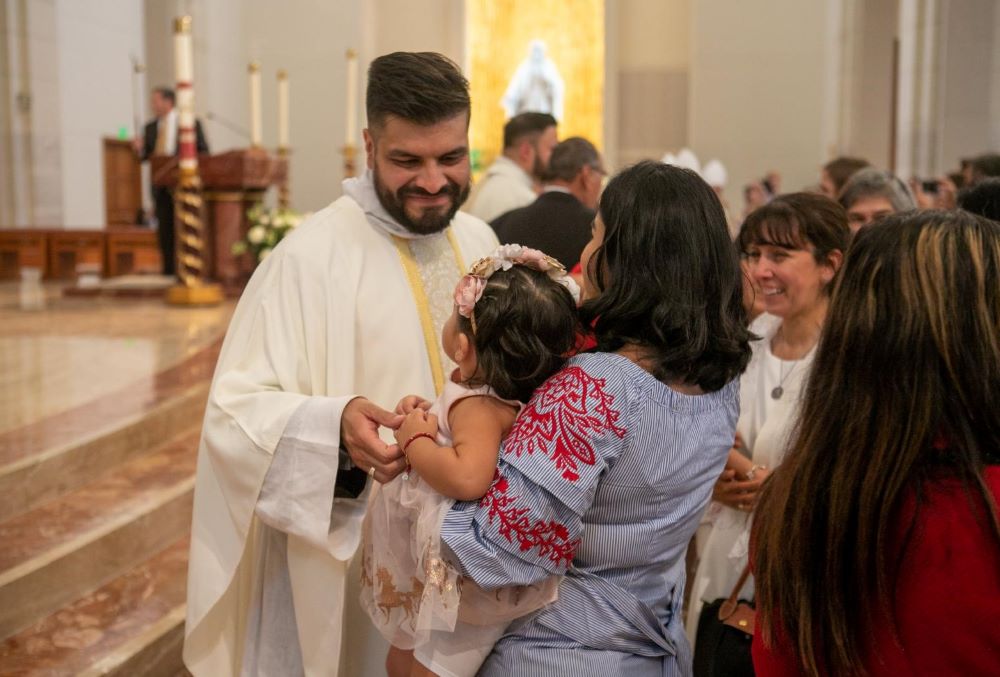
Fr. Luis Garcia is seen during a Mass of ordination to the priesthood at the Co-Cathedral of the Sacred Heart in Houston June 4, 2022. Garcia was one of two Hispanic and Latino priests ordained in Galveston-Houston that year. A Hispanic Serra Club in the Archdiocese of Galveston-Houston promotes and inspires new vocations to the priesthood and religious life with a focus on Hispanic and Latino populations. (CNS/ Texas Catholic Herald/James Ramos)
"There's definitely a cooling off. About a third of those who were born Latino and Catholic are disaffiliated. They prefer not to identify as Catholic, even though a certain number of them certainly they probably will want to baptize their children if they should have children," he said.
It's not what people usually are referring to when they talk about “assimilation.” Will Catholics in America face the same shocking downdrafts as Lutherans, Methodists and Episcopalians, just on a different schedule? Like your local TV weatherman says, the map is in motion.
Will Catholics in America face the same shocking downdrafts as Lutherans, Methodists and Episcopalians, just on a different schedule? Like your local TV weatherman says, the map is in motion.
A generationally healthy parish
Back at St. Emydius, the long-distance parking spot and the hike to church made me a few minutes late. In most churches in America that is a small matter. Whenever you get there, there is room. At St. Emydius, being a few minutes late meant I would stand in a side aisle at the back of the church for the entire Mass. Every last spot where a human being might park their rear end, from the front pews by the altar, to the transepts at left and right of it, to the side chapels and the very last pew, was packed.
There are 10 Sunday Masses at St. Emydius. Nine are in Spanish. Just one is in English. My aisle spot was a great vantage point from which to watch something special: Mass in a packed church. Lynwood is a city of roughly 70,000 people, according to the 2020 Census about 88% Latino, 8% Black or African American, and a little over 2% "non-Hispanic White" to use the census term, or "Anglo," in commonly-used California terms.
St. Emydius was built in 1948, during a decade when Lynwood more than doubled in population, its fastest growth in the entire 20th century. It is a building not all that different from hundreds that rose in American suburbs as the Catholic Church followed the faithful out of ethnic ghettoes and ports of entry into new, auto-dependent suburbs. Just as Lynwood has changed since it was the birthplace of Venus Williams and Kevin Costner, and the boyhood home of late NFL Commissioner Pete Rozelle and "Weird Al" Yankovic, St. Emydius probably looks a little different from a place that would be built today for an overwhelmingly Mexican and Mexican American congregation.
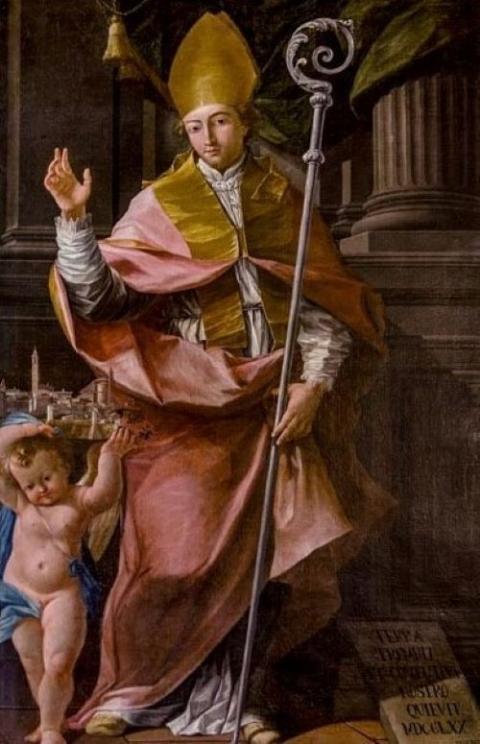
St. Emydius is believed to have saved his episcopal seat of Ascoli Piceno in Italy from an 18th-century earthquake. (Wikimedia Commons/CC BY-SA 4.0)
On the right side of the nave a stained-glass window honors St. Thomas More, King Henry VIII's Lord Chancellor and Reformation-era martyr and defender of the Catholic faith. Across from St. Thomas on the left side of the nave is St. Patrick, the patron of Ireland. To one side of the altar is St. Emydius himself, a third-century native of the Rhineland who moved to Rome and became a bishop. As befitting a man venerated in Los Angeles County, he is believed to have saved his episcopal seat of Ascoli Piceno in Italy from an 18th-century earthquake. Many depictions of him, like the one in the California church, show him holding back tumbling masonry.
On the other side of the altar is an image of Our Lady of Guadalupe, patroness of Mexico, with a crowd at her feet before and after Mass. A life-sized infant Jesus in a white baptismal gown floats above the altar. The celebrant reminded us we were approaching La Candelaria, Candlemas, the feast of the Presentation of Jesus Christ. El Niño would come down as Ordinary Time began, and Lent approached.
I've been to Mass all over the world, and in my fifth decade as a reporter, can tell you a demographic dumbbell is forming, an "unmiddling" of the church in generational terms. The people I've seen in the pews are younger, and older, and increasingly less likely to be anything else.
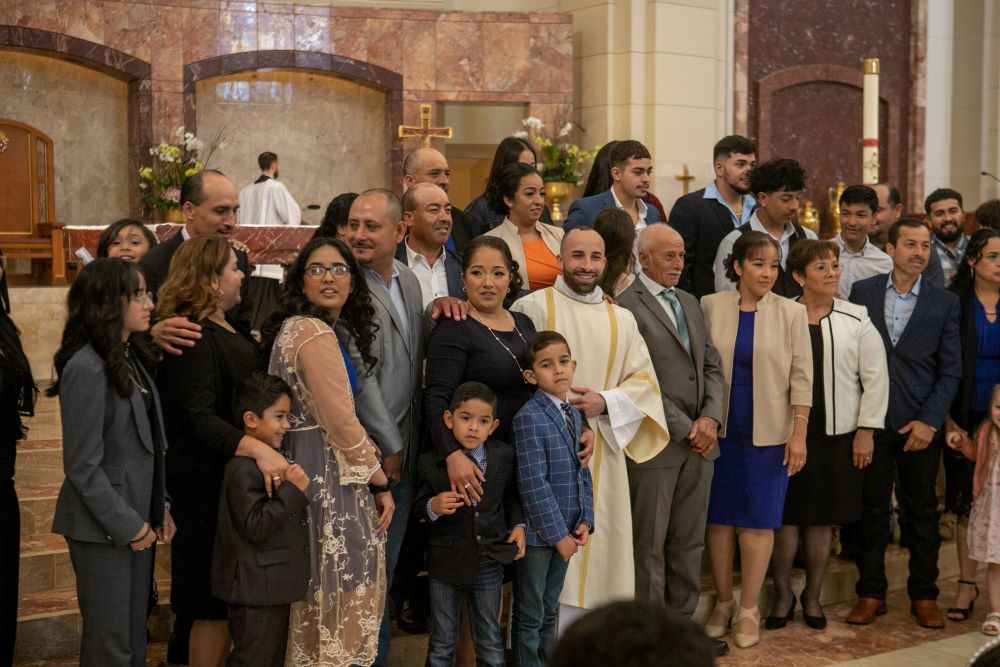
Deacon J. Serrato poses for a group photo after his Mass of ordination to the transitional diaconate May 14, 2022, at the Co-Cathedral of the Sacred Heart in Houston. (CNS/Texas Catholic Herald/James Ramos)
At St. Emydius, banners on the left and right pillars of the marble baldachin carry the bilingual mandate, Escucha y Siguelo, Listen and Follow. That command, one made easily over the centuries by a church confident in its authority, might hint of the shape of the challenge for 2023.
Deck from Loyola Marymount calls deepening disagreement with church teaching the biggest challenge going forward. He told me young people are "turned off by a church that seems to them to be kind of locked in its certainties, certainties that it puts forward and a certain morality that young people frequently find very off-putting."
"I mean, it's not rocket science that it doesn't model the attitude of Christ. So they're turned off," the professor said, while extolling the more welcoming, more loving approach of his fellow Jesuit, Pope Francis.
I happened to visit St. Emydius on a Sunday celebrating the parish school. Scores of children were in the pews, during the Spanish and English Masses, dressed in their school uniforms, praying and singing and coming to Communion with their parents. There were also lots of babies in arms, older teenagers, young adults and the elderly. If anything, these were the most generationally healthy congregations I had seen in any Christian house of worship in a long time.
When you walk out into the courtyard next to the church, into the bright winter sunshine, the people who are pillars of the church everywhere are staffing tables selling snacks to raise money for an upcoming youth activity, religious articles, books and pamphlets. There's laughter and chatting from table to table, in Spanish among adults, and a mix of English and Spanish to the children milling, playing and laughing.
Challenges of mega-parishes
Deck was interested in my report from Lynwood as we walked on the gorgeous Loyola Marymount campus, on a bluff with a commanding view of the Pacific to the west, and Westchester to the east. While we talked about the impressive size of this LA County congregation, Deck wondered about pastoring 20,000 families, the success in holding on to such a vast parish family and the challenge embedded in "more viable" sized communities.
"The average size of an Evangelical congregation is much smaller," he said. "Even the megachurches are broken down into small groups of various sorts." Deck called the size differences so vast, the churches are really "apples and oranges."
"Our response has been, at least here in the West, to build bigger churches," he said. "And yet, unless you can somehow create a dynamic of small community inside that bigger church, you're ultimately going to be alienating people, because it's going to be a kind of anonymous exercise of their religion."
The congregation standing for the procession that begins the lone English-language Mass is a fraction of the size of the Spanish-language congregations before and after. I suspect one reason the sanctuary is even this full is that worshipers who would be comfortable in either language know it is easier to get a seat. No small number of communicants speak to each other, and to their children, in Spanish.
On this morning the pastor, Fr. Rigoberto Rodriguez, is the celebrant, a beaming, high-touch presence making his way down the aisle. He touches shoulders and shakes hands, cradles the cheeks of children and blesses babies in arms. Rodriguez, too, is an immigrant, and his homily is sprinkled with anecdotes from his own time as a newcomer in Southern California, a rallying call to faith and a warning against the excesses of materialism.
Advertisement
The church's latest Encuentro, the process of study, assessment, and fine-tuning outreach to Latino Catholics in the United States, found that in a church that is more than 50% Latino, fewer than one in 12 priests are, and of that number, three in five come from another country. The fifth Encuentro in 2018 found that in the U.S. today, "there are about 2,000 Catholics for every priest; 6,000 immigrant Hispanic Catholics for every immigrant Hispanic priest; and 23,000 U.S.-born Hispanic Catholics for every U.S.-born Hispanic priest."
When the English Mass is over, one crowd heads out to the street and courtyard, while another waits patiently outside. The pastor is doing his best to hold back the threatened alienation, switching back and forth from Spanish to English, accepting and giving well-wishes. He is alive, engaged, encouraging and given a big assignment: to hold on to this flock at a time of strong headwinds from an increasingly irreligious country, fully aware that keeping them engaged and present will have a lot to say about the church's future in this country.
